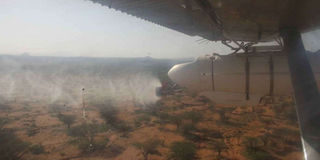Safer, more effective ways to control locusts

The government uses aerial spraying to fight off desert locusts in Moibei, Isiolo County, on January 17, 2020. PHOTO | FILE | NATION MEDIA GROUP
What you need to know:
- But now that new breeding has begun, this is an important opportunity for Kenya to safely limit further devastation by the insect pests.
- Strategies for harvesting and processing locusts as either human or livestock food should be promoted but only in areas with no chemical spraying.
The desert locust outbreak in northern Kenya poses serious and long-term socioeconomic difficulties for the East African region with a persistent food insecurity.
The government’s emergency response effort to the invasion of the migratory locust swarms has been spraying a number of chemical insecticides with varying results.
Unfortunately, aerial and ground spraying contaminates not only the locusts being targeted but everything in the environment, including the vegetation and waterways that livestock and humans are dependent upon.
The chemicals used include Fenitrothion, Fipronil and Chlorpyrifos, which are broad-spectrum insecticides.
They are not limited to killing locusts; they will affect many other types of insects, particularly bees and other social insects, and higher organisms such as birds and reptiles.
Large-scale spraying of hundreds of thousands of litres of insecticides will be felt up and down the food chain for a long time and expose livestock and people, especially those handling, storing and spraying the pesticides.
BIOLOGICAL INSECTICIDE
The government now says the locusts will take at least six months to control, and the Food and agriculture Organisation (Fao) of the United Nations has stated the locust numbers will increase as a new generation of breeding has already begun.
Experts agree that the most effective time for controlling locusts is just after hatching, during the nymphal stage, when they are more commonly known as hoppers, and prior to developing the ability to fly.
Hoppers are gregarious and quickly form hopper bands, which feed and move as a collective unit.
Unfortunately, the wider region’s organisational and logistical challenges prevented the early detection of the original hopper bands.
But now that new breeding has begun, this is an important opportunity for Kenya to safely limit further devastation by the insect pests.
Fortunately, there are safe and effective alternatives to chemical insecticides for eradicating hopper bands.
Metarhizium acridum (trade name Green Muscle), as well as a newer version NOVACRID. M. acridum, is a biological insecticide.
More specifically, it is a fungus that causes disease only within the Acrididae or grasshopper family.
STATE APPROVAL
M. acridum has been widely tested and operationally used all over the world, including in Africa, for its effectiveness, safety to non-target organisms and lack of environmental persistence.
It has been proven to be a much safer and effective alternative to chemicals. Hopper bands usually disappear in 10 to 15 days, often helped by predators that can easily catch the sick hoppers.
Nut neither Green Muscle nor NOVACRID are registered for use in Kenya despite being recognised in the Sahel region and Central Asia.
With locust eggs set to hatch in Kenya this month and new swarms expected by early April, the government should urgently grant a waiver of registration and import permit for M. acridum, which is widely acknowledged as a safe and effective alternative to chemical insecticides for the control of locusts by even the FAO.
Strategies for harvesting and processing locusts as either human or livestock food should be promoted but only in areas with no chemical spraying.
Dr Ogada is assistant director of Africa Programs, The Peregrine Fund. [email protected]




